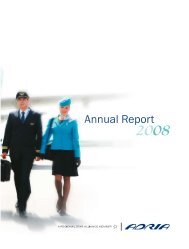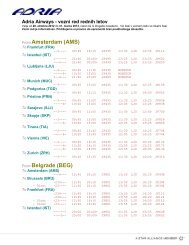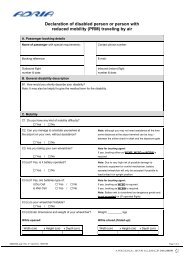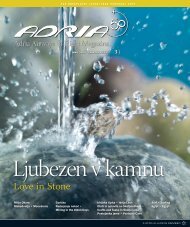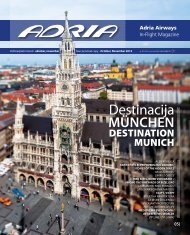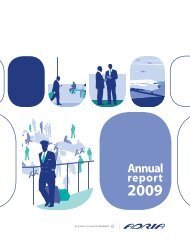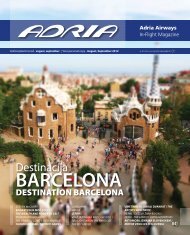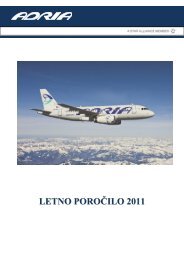København - Adria Airways
København - Adria Airways
København - Adria Airways
You also want an ePaper? Increase the reach of your titles
YUMPU automatically turns print PDFs into web optimized ePapers that Google loves.
ADRIA airwaysAerofoils can be thin, medium or thick; thin aerofoils are used for highflying speeds and thicker ones for lower speeds.At the same speed of flying,a thicker aerofoil will generate morelift than a thin one.Since a thickeraerofoil also creates more drag, it is important to select an aerofoil that willprovide an optimum ratio between lift and drag, taking into account theaircraft’s intended use.Wing areaThe larger the wing area, the greater the lift generated. Wing planforms vary.Wings can be rectangular, trapezoidal, elliptical, or a combination of these,depending on what type of flying the aircraft will be used for. Most aircraft usetrapezoidal wings, whereas aircraft flying at supersonic speeds use delta wings.During take-off and landing, when aircraft speeds are low, lift is increased byusing the aerodynamic surfaces at the front and back of the wings. Wings haveslats at the front and flaps at the back. These aerodynamic surfaces give thewing not only a bigger area but also greater curvature and allow the airflow topass the wing correctly even at lower speeds. The deflections of slats and flapsare smaller during take-off and greater during landing.Angle of attackThe angle at which the airflow meets the wing is called the angle of attack.The greater the angle of attack, the greater the lift. However, lift only increasesup to a certain angle of attack and then starts to decrease as the airflowseparates from the wing’s surface and its flow around the wing is disrupted.The angle of attack at which lift is disrupted depends on wing thickness,curvature and depth, and the use of slats and flaps. In the case of disruptedlift, if the aircraft is in level flight it will drop its nose (without any input fromthe pilot) and the angle of attack will decrease, increasing lift. If, on the otherhand, the aircraft is banked to one side, disrupted lift may send it into a spin,which means a steep downward spiral. Passenger planes have a built-insystem which warns of this danger and prevents it from happening.Air densityAir density falls with altitude; it is 1.2 kg per cubic metre at sea level but only0.73 kg per cubic metre at an altitude of 5,000 m. The air is likewise denser ona cold winter day than on a hot summer day. A change in density affects theaircraft’s lift. In the thin air found at the altitudes at which modern planes fly,this kind of reduction in lift must therefore be compensated with speed, inorder to sustain the balance of forces and hence flight.When dealing with the motion of aircraft through the air we should alsomention drag, i.e. the force which decelerates motion and therefore needs tobe overcome with engine power. Drag caused by the shape of an aircraft iscalled form drag, while drag caused by the lift generated on the wing is calledinduced drag (this results from the balancing of pressures at the end of thewing and leaves a swirling trail behind the plane); there is also drag causedby friction between the air and the aircraft. Drag is harmful and the aim is toreduce it to a minimum. This is reflected particularly in fuel consumption andthe aircraft’s flight range.However, at certain stages of a flight, drag is desirable and the pilot will use airbrakes located on the upper surface of the wing. Their deployment increasesdrag and decreases lift, thus reducing speed and allowing a steeper angle of descent,aerodynamic braking after landing and better contact with the runwayfor more effective braking.Tomaž Konjar, CRJ-200/900 captainFoto: Tomaž Konjar14



